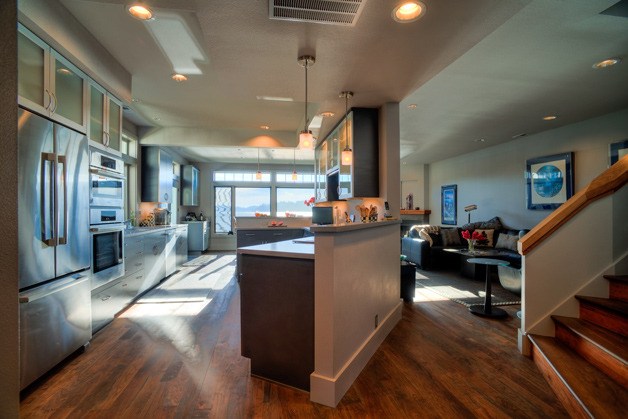Sure, aesthetics are important. But it’s all about function.
That’s the key to creating a home that will make you happy. Just ask Molly McCabe.
McCabe, a residential designer and licensed contractor, is owner of A Kitchen That Works. It’s a business she began in 2002 and since, her husband, Clive Pardy, has joined. Together, they work with builders, to design new construction, and homeowners on remodels.
The business had a very simple beginning.
“I was a pantry consultant,” she said. “I went into people’s kitchens to teach them how to stock a pantry so that when they came home from work at 5 p.m., they’d have everything they needed to make a nutritious meal.”
Her work, which included arranging the kitchen so it made sense, was aimed at busy parents who needed help getting organized.
“I showed clients where to put their pots and pans so that they were close to the stove or where they’d need them. And I taught them how to use kitchen equipment properly.”
Shortly after that, a client asked if she would design her kitchen.
“And it just morphed from there,” McCabe said.
She has bachelor’s and master’s degrees in finance. She trained with the National Kitchen and Bath Association and has a professional designation. By 2006, she was working as a construction project manager and in 2010, when Washington State Department of Labor & Industries rules changed, she became a licensed contractor.
“Unless you have that license, you can’t be a project manager,” she said.
Shortly after that, she convinced her husband, Clive, to come to work with her. He was previously in the banking industry.
As the business has grown, she’s designed all the rooms in a home. Whether it’s a kitchen or a bedroom, the key is functionality, she said.
“Aesthetics is important, and so is ergonomics,” she said. “But the most important thing is function. Form follows function.”
She usually meets with prospective clients in her showroom, which is next door to her home on Bainbridge Island. But first, she sends them a questionnaire.
“It includes a list of questions they should ask me, too,” she said. “It’s a way to get to know what the client really wants and what they should expect from my work. It’s all about collaboration. I require them to participate. This is not about me. It’s about them. I tell the client it’s a reflection of you and how you live.”
Each project is personal, she said, and at the end of the conversation, if they agree, they write a contract for the project. She begins on the design and specifications and gives the client an estimate for the costs. And then construction begins.
At any one time, her company can have as many as seven projects at various points of progress. She and her husband are hands-on and are at the project locations often throughout the remodeling process.
One of the benefits of having her showroom next to her home is that she can show clients through her own home, which she redesigned and remodeled.
They can see the difference between pull out closet doors, which can block hallways, or using a folding closet door which bends into the wall. She also has examples of an induction countertop range, a steam oven and sensor faucets.
In her one-stop shopping showroom, she has samples of floor coverings, countertops, hardware and everything needed to complete a remodel. She uses the Universal Design Principle: that usage of space is acceptable to anyone of any ability.
“It needs to be seamless and comfortable,” she said.
One of her greatest assets, she said, is that she can visualize blueprints in full color 3D.
“My dad was the same way,” she said. “But I was about 40 before I figured out that not everybody sees like I do.”
She tells a story about how that helps. A client was describing how he wanted the cabinets on the walls in the kitchen.
“I told him that wouldn’t work because then, the door wouldn’t open,” she said. “He said ‘What do you mean?’”
It was because she could see in three dimension how the finished project would be, that she saved the client from a very expensive mistake.
McCabe has received many professional awards including Best In Show at several home shows, and Best of WestSound Readers for Best Remodeler and Designer and the 2009 Environmental Construction & Design Excellence Award. She is a “Green” professional and recycles products and product waste including Styrofoam which she personally drives to Seattle for recycling. She also uses locally-made products and hires local labor.
While she’s gotten to do many projects throughout a 30-mile radius, there’s still one thing she’d like to design that she hasn’t gotten the chance to.
“An elevator,” she said. “Because it would be challenging. And because adding an elevator to an existing home would mean the homeowners would be able to stay in a home they love as long as they chose to, not as long as the house allows them to.”
Her favorite part of her job?
“Seeing the looks on the clients’ faces when they see their home once it’s finished,” she said. “They see that they can have more than they thought they could.”
To find out more, go to www.akitchenthatworks.com, or call 206-780-1906.



